Water supply station: general information and practical
What are water pumping stations? What functions can they perform in the water supply systems of private and multi-family houses? How to properly connect the pumping station to the water supply when water is supplied from the well? Let's figure it out.
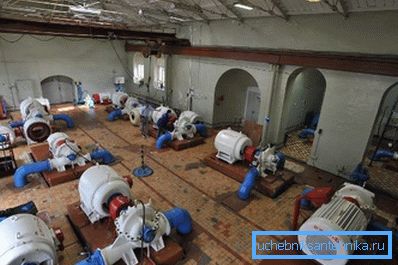
What it is
The pumping of an apartment building is one or several stationary pumps providing water to the upper floors with a lack of pressure in the route.
In what cases is their installation necessary?
- With low-rise surrounding buildings. In SNiP 2.04.02-84, it is directly recommended for areas built up with one-story houses to maintain the pressure in the water mains at the level of 10 meters.
Reference: 10 meters of water column correspond to an overpressure of one atmosphere. Speaking in a somewhat simplified way, each pressure atmosphere in the line provides for the rise of water to three floors.
- With a significant deterioration of the highway and the impossibility of its repair or replacement for any reason. Steel pipes, which replaced pig-iron water pipes in the second half of the last century, for twenty to thirty years of operation, are overgrown with lime and rust, which leads to a decrease in throughput by several times.
- With significant differences in terrain. The pressure of 3.5 kgf / cm2 is enough to provide water for a nine-storey building on a plain; but for the same house, standing on a 20-meter hill, it is necessary to have at least 5.5 kgf / cm2.
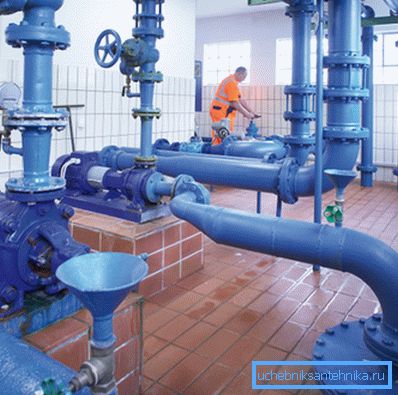
Water stations for domestic water supply or for summer cottages are relatively inefficient surface centrifugal pumps with their own accumulators that provide autonomous water supply from natural sources.
Since, as already mentioned, the pressure drop to one atmosphere can raise a water column by 10 meters, any surface station cannot operate at a greater distance from the water mirror to the surface. The impeller of the pump does not create an absolute vacuum, therefore, in practice, the maximum depth is even smaller - 7-9 meters.
The price of the cheapest surface pumps is about 4-5 thousand rubles. The maximum cost is determined both by the performance of the product and by the name of the manufacturer: you can find stations for sale that will cost the owner 100 or more thousand rubles.
Note: Western products cost much more expensive than domestic devices of the same functionality. Reasons - shipping costs and customs duties.
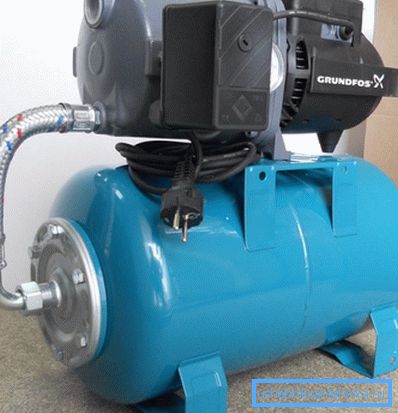
To familiarize the reader with the subject of our research, we present the main characteristics of the pumping station of domestic production of BISON ZNAS-1200.
| Parameter | Value |
| Electric power | 1200 watts |
| Depth of water mirror | Up to 9 meters |
| Maximum head | 40 meters |
| Performance | 3.78 m3 / hour |
| Retail value | 8850 rubles |
Installation
Connecting the pumping station to the water supply is determined primarily by its class.
Swapping
Stationary swaps are mounted on a reinforced concrete foundation that does not have a bond with the foundation of the building (in order to exclude the transmission of vibration). The station bed is usually ankered to the foundation; anti-vibration mounts (spring or with rubber gaskets) are less commonly used.

The suction port of the cochlea of the pump (located along its longitudinal axis) cuts into the water meter assembly after the valves and the counter; the output is connected directly to the bottling of cold water. Between tie-ins is required bypass larger than the tie-in pump diameter with a check valve, valve or valve.
Why is it needed?
- When the pump is operating, the bypass is blocked and does not allow it to drive water in a circle.
- When the pump is turned off, the open bypass supplies the house with water, without limiting its flow to the tie-ins and snail passability.
In addition: a constant flow of water through the idle pump will lead to rapid overgrowth of the cochlea.
When installing the cochlea and the electric motor, their shafts must be strictly coaxial: the beating will quickly destroy the coupling or flange pipe connection.
If, for some reason, coaxiality cannot be ensured, a simple instruction will save the situation:
- The motor and the cochlea are spread on the bed so that between the flanges of the shafts there is 3-4 cm.
- The flanges are connected with flexible straps tightened with bolts. They are easy to cut your own hands from the conveyor belt.
Before installing the pump, it is highly recommended to install a sump. Sand and dross is not uncommon in the cold water supply main; hitting a rotating impeller, at best they will accelerate its wear, and at worst they will crumble one or more blades.
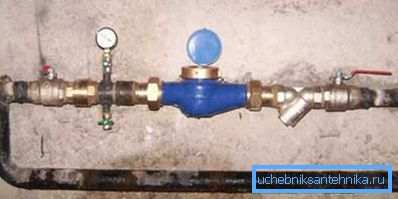
In addition, the tie-in is better to provide a shut-off valve pumping. Spherical cranes are best suited for this role: in addition to fault tolerance, they have an exceptionally low hydraulic resistance.
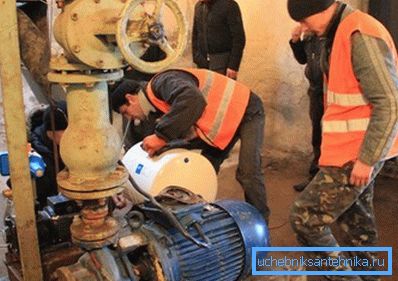
Periodic maintenance of the pump is reduced to periodic packing of the gland.
Water supply from the well
In this case, the scheme of connecting the pumping station to the water supply system is extremely simple: it is enough to connect the outlet of the pump to the water supply system, lower the intake pipe to a well or other reservoir and supply power.
Subtleties, however, there are here.
- The end of the intake pipe must be provided with a check valve. Otherwise, if you stop the power supply of the pump, the water will simply flow back.
- How to connect the pumping station to the water supply if you plan to use the water year-round? It is necessary to insulate the well and the pump installed next to it reliably, and to lay the water inlet from the well deeper than the level of freezing. The simplest way to do reliable thermal insulation with your own hands is to build a house with insulated walls above the well.
By the way: the house at the same time completely solve the problem of noise from the pump.
- To protect the pump from debris (branches, dead leaves, etc.) the inlet is protected by a mesh filter.

- The installation after the pumping station of an additional hydroaccumulator will help to increase the periods of pump downtime. The greater its capacity, the longer the pause in the station. The scheme with an additional accumulator, however, will only work until the pumping speed exceeds the flow rate of the well.

Conclusion
We hope that our material will be useful both for the installation of swapping and for the construction of an autonomous water supply system of a private house or cottage. The video in this article, as always, will offer additional information. Successes!